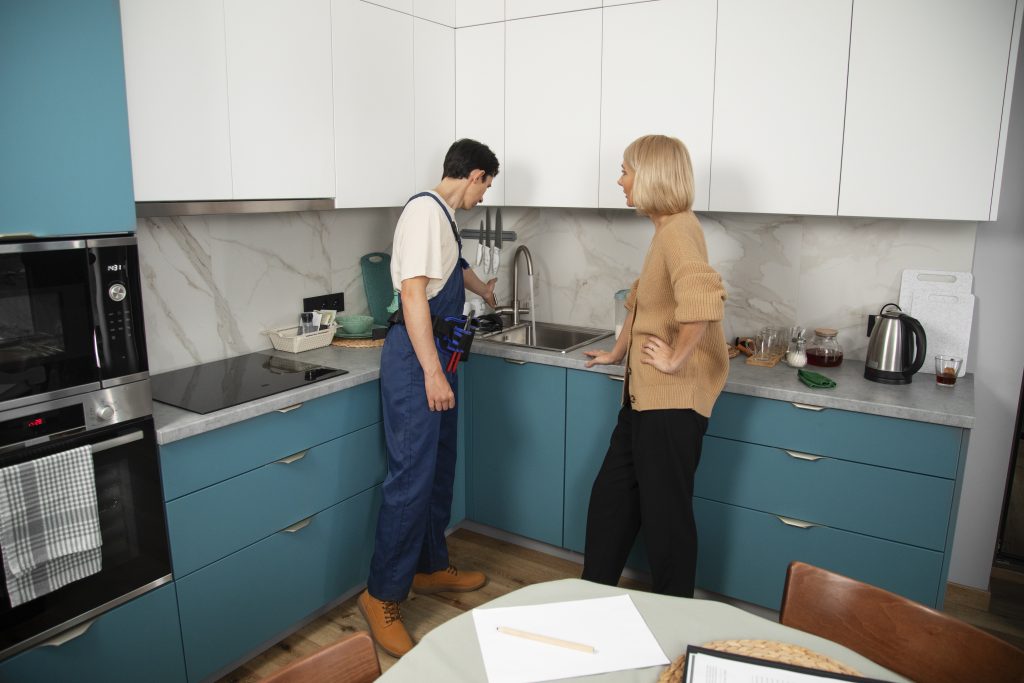Transforming Kitchens Into Functional Spaces
Jessica White August 18, 2025
Kitchens have always been central to daily life, but in 2025 they are becoming much more than a place to cook. Today, homeowners want functional spaces that combine practicality, comfort, and flexibility. The shift reflects changes in how people live, work, and interact at home. Kitchens are now doubling as home offices, wellness hubs, and even entertainment zones—all while still serving their traditional role.
In this article, we’ll explore the emerging trends in transforming kitchens into functional spaces, why these changes matter, and how homeowners can integrate these ideas into their own homes. Along the way, we’ll highlight case studies and expert insights to show how design and innovation are shaping the kitchens of tomorrow.

Why Functional Kitchens Are in High Demand
Several social and economic factors are driving the demand for functional kitchens:
- Remote Work and Hybrid Lifestyles: Millions of people continue to work from home, often using kitchen islands or dining areas as makeshift workstations. According to Pew Research Center, about 35% of workers with jobs that can be done remotely still work from home full-time or part-time as of 2024. This makes flexible kitchen spaces more valuable than ever.
- Rising Food Costs and Health Awareness: With grocery prices increasing, more families are cooking at home and focusing on meal planning. This requires better storage, efficient appliances, and layouts that support regular food prep.
- Smaller Homes and Urban Living: Apartments and townhouses often feature compact kitchens, which demand creative design solutions to maximize usability.
- Sustainability and Energy Concerns: Homeowners want energy-efficient, eco-conscious kitchens that help reduce long-term costs and environmental impact.
Trend 1: Multi-Functional Kitchen Layouts
A traditional kitchen layout often centered on food prep and storage, but modern layouts are designed for versatility. Multi-functional kitchens adapt to the varied roles kitchens now play.
- Convertible Islands: These aren’t just for cooking. Many new designs integrate hidden storage, extendable tables, or even drop-down desks. For instance, a homeowner in Austin, Texas redesigned their kitchen island to serve as both a family dining spot and a laptop workstation during work hours.
- Hidden Workstations: Pull-out counters or pocket desks that slide away when not in use help balance home and work life.
- Zoned Kitchens: Designers now focus on dividing kitchens into functional zones—prep, cook, clean, and work—to streamline daily tasks.
The 2024 Houzz Kitchen Trends Study reported that 56% of homeowners installing islands added seating to make the space more versatile. This reflects the rising demand for kitchens that serve multiple roles beyond cooking.
Trend 2: Smart Technology Integration
Functional kitchens in 2025 are tech-enabled, with appliances and systems designed to save time, reduce waste, and improve convenience.
- Voice-Activated Appliances: Ovens that preheat via voice command or coffee makers that start brewing when you wake up.
- Smart Refrigerators: These now come with cameras, expiration date trackers, and app integration to reduce food waste.
- AI-Enhanced Ovens: Some models automatically adjust cooking times based on the dish and portion size.
- Smart Lighting and Climate Control: Adaptive lighting and ventilation make kitchens more comfortable for cooking and working.
Statista estimates the global smart kitchen appliance market will exceed 43 billion dollars by 2026. This growth highlights how essential connected devices are becoming in modern households.
Trend 3: Sustainability and Eco-Friendly Choices
Environmental consciousness is a central feature of functional kitchens. Homeowners are choosing sustainable solutions that reduce waste and save money in the long run.
- Energy-Efficient Appliances: Induction cooktops are safer, faster, and more energy-efficient than gas stoves.
- Recycled Materials: Countertops made from recycled glass or composite stone are durable and environmentally responsible.
- Low-Waste Fixtures: Touchless faucets with flow control reduce water waste during cooking and cleaning.
The EPA notes that households adopting energy-efficient appliances can cut energy bills by as much as 30%. Sustainability isn’t just about values—it’s about long-term savings.
Trend 4: Compact and Space-Saving Solutions
As more people live in apartments or smaller homes, kitchens must be designed for efficiency without sacrificing comfort.
- Vertical Storage Systems: Pull-out pantries, hanging racks, and tall cabinets make full use of wall space.
- Appliance Garages: These hide small appliances behind retractable doors, keeping counters clear.
- Foldable Surfaces: Drop-down tables and sliding counters provide extra workspace only when needed.
In Tokyo, for example, many new apartment kitchens include built-in foldable counters that disappear into cabinetry—proof that small kitchens can still feel spacious with smart design.
Trend 5: Wellness-Oriented Kitchen Design
The wellness kitchen movement emphasizes creating spaces that support physical and mental health.
- Hydration Stations: Built-in filtration systems or sparkling water taps encourage healthier drinking habits.
- Fresh Storage Options: Refrigerators with specialized drawers for produce help preserve nutrients longer.
- Natural Lighting: Skylights and large windows reduce reliance on artificial light, improving mood and energy.
- Non-Toxic Materials: Low-VOC paints and sustainable cabinetry reduce harmful chemicals in the home.
According to the Global Wellness Institute, the wellness real estate market (homes designed for health) is projected to grow 16.1% annually, making kitchens a prime area for wellness-focused upgrades.
Case Studies: Functional Kitchen Success Stories
To see these ideas in practice, here are a few real-world examples of transforming kitchens into functional spaces:
- Brooklyn Apartment Renovation (2024): A 600-square-foot apartment featured a galley kitchen. Designers installed sliding glass panels that opened to the living area, added vertical storage, and used a foldable island for dining and work. The result: a kitchen that functioned as a cooking, working, and entertaining hub.
- Seattle Family Home Upgrade (2025): The family opted for smart appliances, including a fridge that tracked grocery items and sent notifications when milk was running low. They paired this with a sustainable induction cooktop, cutting energy use by 20%.
- Los Angeles Wellness Kitchen (2023): Designers emphasized natural lighting, a water filtration system, and non-toxic finishes. The space doubled as a health hub, with fresh herb planters integrated into the cabinetry.
Expert Insight: What Designers Are Saying
Interior designers are quick to highlight why functional kitchens are becoming the new norm.
- Julia Chen, Kitchen Designer (2025): “Clients want kitchens that grow with them. Whether that means an island that can double as a study table or appliances that save energy, flexibility is the priority.”
- Marcus Hill, Sustainable Architect: “Sustainability isn’t just about eco-friendly materials. It’s about designing kitchens that waste less food, use less energy, and last longer without constant renovation.”
- Nora Patel, Home Wellness Consultant: “We’re seeing more demand for kitchens that support wellness—from hydration features to air-purifying systems. People want kitchens to feel healthy, not just functional.”
Practical Guide: Steps to Transform Your Kitchen
If you’re planning to upgrade, here’s a step-by-step approach to creating a functional kitchen:
- Assess Lifestyle Needs
- Do you need workspace?
- Do you cook daily?
- Do you entertain often?
- Plan for Multipurpose Use
- Invest in a flexible island.
- Add USB ports and outlets.
- Integrate Smart Technology
- Choose appliances with built-in AI.
- Install voice-activated lighting.
- Maximize Storage
- Use pull-out pantry systems.
- Opt for hidden storage for small appliances.
- Choose Eco-Friendly Options
- Select Energy Star-rated appliances.
- Use durable, recycled materials.
- Design for Wellness
- Prioritize natural light.
- Add water filtration and healthy storage systems.
The Future of Kitchen Design
Looking ahead, kitchens will continue evolving into functional spaces that serve as the center of work, health, and family life. The design emphasis is shifting from appearance alone to adaptability, sustainability, and wellness.
In 2025, the kitchen isn’t just a room—it’s a reflection of how people live. The rise of multipurpose layouts, smart technology, compact solutions, and wellness-centered design ensures that kitchens remain one of the most innovative areas of the modern home.
References
- Houzz. (2024). 2024 U.S. Kitchen Trends Study. Available at: https://www.houzz.com (Accessed: 18 August 2025).
- Statista. (2023). Smart Kitchen Appliances Market – Statistics & Facts. Available at: https://www.statista.com (Accessed: 18 August 2025).
- U.S. Environmental Protection Agency. (2024). Energy Efficiency in Appliances. Available at: https://www.epa.gov (Accessed: 18 August 2025).







